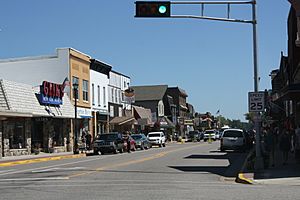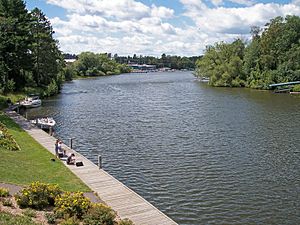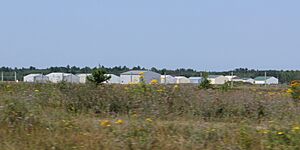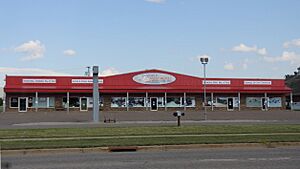Eagle River, Wisconsin facts for kids
Quick facts for kids
Eagle River, Wisconsin
|
|
|---|---|

Downtown Eagle River
|
|

Location of Eagle River in Vilas County, Wisconsin.
|
|
| Country | |
| State | |
| County | Vilas |
| Area | |
| • Total | 3.41 sq mi (8.84 km2) |
| • Land | 3.24 sq mi (8.40 km2) |
| • Water | 0.17 sq mi (0.44 km2) |
| Elevation | 1,647 ft (502 m) |
| Population
(2020)
|
|
| • Total | 1,628 |
| • Density | 490.90/sq mi (189.53/km2) |
| Time zone | UTC-6 (Central (CST)) |
| • Summer (DST) | UTC-5 (CDT) |
| Zip Code |
54521
|
| Area code(s) | 715 & 534 |
| FIPS code | 55-21625 |
| GNIS feature ID | 1579167 |
Eagle River is a city in Vilas County, Wisconsin, United States. In 2020, about 1,628 people lived there. It is the main city, or county seat, of Vilas County. Many lakes are in the area, making Eagle River a popular place for vacations and for people to retire. The city has many vacation homes and cabins.
Contents
History of Eagle River
Early Native American Settlements
Eagle River was once home to the first Native American settlement in the Wisconsin Northwoods. This settlement was on the shores of Watersmeet Lake. Here, the Wisconsin River and Chain O' Lakes meet. The first people were called Old Copper Indians. Later, the Woodland Indians lived here from 2,600 B.C. to 800 A.D. These groups were likely the ancestors of the Chippewa, Potawatomi, and Menominee tribes.
How Eagle River Was Founded
The first white settler in what is now Vilas County was Ashman in 1818. He set up a trading post in Lac du Flambeau. Eagle River got its name because many eagles nested along the river. People believe that Bethuel Draper and "Dutch Pete" Cramer camped here in 1853. They are thought to have given the community its name. More families settled in the area in 1857, and a town grew. The town of Eagle River was officially created by the state in 1885.
Vilas County was formed from Oneida County on April 12, 1893. It was named after William Freeman Vilas, who was a senator for Wisconsin. In the 1850s, people from New England built many roads and trails through Vilas County. These included the Ontonogan Mail Trail and a Military Road.
Geography and Climate
Location of Eagle River
Eagle River is in southeastern Vilas County. It sits along the Eagle River, which is part of a famous chain of lakes. The Eagle River/Three Lakes Chain of Lakes has 28 lakes. This is the largest group of connected inland lakes in the world.
The city covers about 3.20 square miles (8.29 square kilometers). Most of this area is land, with a small part being water.
Eagle River's Climate
Eagle River has a cool humid continental climate. This means it has long, cold winters and short, mild summers. The temperature drops below 32°F (0°C) for about 190 days each year. It gets colder than 0°F (-17.8°C) for about 39 days. Summers are comfortable, with temperatures rarely going above 90°F (32.2°C).
| Climate data for Eagle River, Wisconsin (1991–2020 normals, extremes 1939–present) | |||||||||||||
|---|---|---|---|---|---|---|---|---|---|---|---|---|---|
| Month | Jan | Feb | Mar | Apr | May | Jun | Jul | Aug | Sep | Oct | Nov | Dec | Year |
| Record high °F (°C) | 48 (9) |
56 (13) |
79 (26) |
82 (28) |
93 (34) |
94 (34) |
99 (37) |
96 (36) |
90 (32) |
83 (28) |
73 (23) |
57 (14) |
99 (37) |
| Mean maximum °F (°C) | 38.3 (3.5) |
44.3 (6.8) |
57.6 (14.2) |
72.9 (22.7) |
82.6 (28.1) |
87.8 (31.0) |
89.0 (31.7) |
86.7 (30.4) |
83.2 (28.4) |
73.2 (22.9) |
55.7 (13.2) |
43.1 (6.2) |
90.6 (32.6) |
| Mean daily maximum °F (°C) | 21.2 (−6.0) |
25.8 (−3.4) |
37.1 (2.8) |
50.2 (10.1) |
65.1 (18.4) |
74.7 (23.7) |
78.1 (25.6) |
75.3 (24.1) |
67.4 (19.7) |
52.9 (11.6) |
38.0 (3.3) |
26.3 (−3.2) |
51.0 (10.6) |
| Daily mean °F (°C) | 11.7 (−11.3) |
14.5 (−9.7) |
25.2 (−3.8) |
38.2 (3.4) |
52.3 (11.3) |
62.4 (16.9) |
66.0 (18.9) |
63.7 (17.6) |
55.9 (13.3) |
42.8 (6.0) |
29.6 (−1.3) |
18.0 (−7.8) |
40.0 (4.4) |
| Mean daily minimum °F (°C) | 2.2 (−16.6) |
3.2 (−16.0) |
13.3 (−10.4) |
26.3 (−3.2) |
39.4 (4.1) |
50.1 (10.1) |
53.9 (12.2) |
52.1 (11.2) |
44.3 (6.8) |
32.7 (0.4) |
21.3 (−5.9) |
9.8 (−12.3) |
29.1 (−1.6) |
| Mean minimum °F (°C) | −19.9 (−28.8) |
−18.4 (−28.0) |
−11.2 (−24.0) |
10.2 (−12.1) |
25.3 (−3.7) |
35.6 (2.0) |
43.2 (6.2) |
40.2 (4.6) |
30.1 (−1.1) |
20.9 (−6.2) |
4.0 (−15.6) |
−12.0 (−24.4) |
−23.2 (−30.7) |
| Record low °F (°C) | −33 (−36) |
−36 (−38) |
−28 (−33) |
−6 (−21) |
13 (−11) |
26 (−3) |
36 (2) |
32 (0) |
20 (−7) |
10 (−12) |
−11 (−24) |
−24 (−31) |
−36 (−38) |
| Average precipitation inches (mm) | 1.26 (32) |
1.06 (27) |
1.61 (41) |
2.78 (71) |
3.51 (89) |
4.06 (103) |
4.01 (102) |
3.20 (81) |
3.61 (92) |
3.55 (90) |
1.92 (49) |
1.56 (40) |
32.13 (816) |
| Average snowfall inches (cm) | 15.2 (39) |
14.1 (36) |
10.0 (25) |
7.7 (20) |
0.3 (0.76) |
0.0 (0.0) |
0.0 (0.0) |
0.0 (0.0) |
0.0 (0.0) |
2.1 (5.3) |
9.5 (24) |
17.6 (45) |
76.5 (194) |
| Average precipitation days (≥ 0.01 in) | 10.7 | 7.7 | 8.5 | 10.8 | 11.9 | 11.7 | 11.9 | 10.2 | 11.8 | 13.3 | 11.0 | 10.1 | 129.6 |
| Average snowy days (≥ 0.1 in) | 10.8 | 7.4 | 5.6 | 2.7 | 0.1 | 0.0 | 0.0 | 0.0 | 0.0 | 1.1 | 5.8 | 9.0 | 42.5 |
| Source: NOAA | |||||||||||||
Population and People
How Many People Live Here?
| Historical population | |||
|---|---|---|---|
| Census | Pop. | %± | |
| 1890 | 1,150 | — | |
| 1910 | 1,141 | — | |
| 1920 | 672 | −41.1% | |
| 1930 | 1,386 | 106.3% | |
| 1940 | 1,491 | 7.6% | |
| 1950 | 1,469 | −1.5% | |
| 1960 | 1,367 | −6.9% | |
| 1970 | 1,326 | −3.0% | |
| 1980 | 1,326 | 0.0% | |
| 1990 | 1,374 | 3.6% | |
| 2000 | 1,443 | 5.0% | |
| 2010 | 1,398 | −3.1% | |
| 2020 | 1,628 | 16.5% | |
| U.S. Decennial Census | |||
In 2010, there were 1,398 people living in Eagle River. There were 684 households, which are groups of people living together. About 308 of these were families.
Most people living in Eagle River are White. There are also smaller groups of African American, Native American, and Asian residents. Some people are from other races or have mixed backgrounds. A small percentage of the population is Hispanic or Latino.
About 18% of the residents were under 18 years old. About 23% were 65 years or older. The average age in the city was 43.2 years. The population was almost evenly split between males and females.
Healthcare Services
Aspirus Eagle River Hospital is a hospital in Eagle River with 14 beds. It is a Critical Access Hospital, which means it's a smaller hospital in a rural area. There are fewer primary care doctors in Eagle River compared to the rest of Wisconsin. The area is considered a "medical desert" for both general healthcare and mental health services. This means it's hard for people to find doctors. By 2035, Eagle River is expected to have a big shortage of doctors.
Getting Around Eagle River
Main Roads
| U.S. 45 goes north to Land o' Lakes. It goes south to Three Lakes and Antigo. | |
| WIS 17 travels north with US 45 and WIS 32 for about 4 miles (6.4 km). Then it turns northeast towards Phelps. It also goes west with WIS 70 before turning south to Rhinelander. | |
| WIS 32 runs through Eagle River along with US 45. | |
| WIS 70 goes east through the Chequamegon-Nicolet National Forest to Florence. It goes west through St. Germain to Woodruff and Minocqua. |
Eagle River Airport
Eagle River has its own airport, the Eagle River Union Airport (KEGV). It is used by people who own seasonal homes in the area. The airport has about 12,000 flights each year. Most of these are "general aviation" (private planes) and "air taxi" (small planes for hire). The airport has two runways and a helipad.
The closest airport for bigger commercial flights is in Rhinelander, Wisconsin, about 30 miles (48 km) southwest.
Local Media
- WERL (AM) 950, Freedom Talk (a radio station)
- WRJO FM 94.5, Oldies (another radio station)
Fun Activities and Sports
Eagle River is a great place for outdoor fun! Popular activities include boating, camping, fishing, swimming, hunting, and golfing. In winter, people enjoy ice fishing and snowmobiling. You can also see bald eagles here, which is how the city got its name.
Eagle River is known as the "Snowmobile Capital of the World." This is because the World Championship Snowmobile Derby has been held here for over 50 years. It takes place on an ice oval track on the north side of the city. There are more than 500 miles (800 km) of groomed snowmobile trails in the county. The World Snowmobile Headquarters and International Snowmobile Hall of Fame are also in Eagle River.
The Wisconsin Hockey Hall of Fame is located in Eagle River Stadium. This stadium is home to the Eagle River Falcons hockey team. Eagle River has also hosted the Labatt Blue USA hockey pond hockey championship games. Because of these events, Eagle River is also called "The Hockey Capital of Wisconsin."
The city has a public golf course called ERGC. It is located at 457 East McKinley Street, near the airport.
Famous People From Eagle River
- Jim Abrahams, a director and screenwriter
- Charles Comiskey, a former owner of the Chicago White Sox baseball team
- John A. Conant, a lawyer and Wisconsin state politician
- Claire Decker, a racing car driver
- Natalie Decker, a NASCAR driver
- Paige Decker, a racing car driver
- Edward A. Everett, a business owner and Wisconsin state politician
- Herman Finger, a lumber businessman
- Emil Gross, a MLB (Major League Baseball) player
- Craig Ludwig, a NHL (National Hockey League) player and coach
- Sean McKeever, a comic book writer
- Arthur William McLeod, a lawyer and Wisconsin state politician
- Robert Peters, a poet
- Daniel E. Riordan, a teacher, lawyer, and Wisconsin state politician
- Margaret P. Varda, a lawyer and Wisconsin state politician
- Cy Williams, a MLB player
- Jinelle Zaugg-Siergiej, an Olympic athlete
- Jim Rome, a famous sports broadcaster
Images for kids
See also
 In Spanish: Eagle River (Wisconsin) para niños
In Spanish: Eagle River (Wisconsin) para niños












